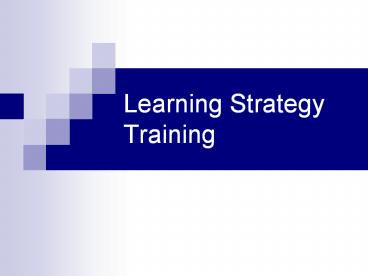Learning Strategy Training - PowerPoint PPT Presentation
Title:
Learning Strategy Training
Description:
Learning strategy training: training students in the use of learning strategies in order to improve their learning effectiveness. Example in the textbook ... – PowerPoint PPT presentation
Number of Views:276
Avg rating:3.0/5.0
Title: Learning Strategy Training
1
Learning Strategy Training
2
Background
- 1975, Rubin good language learners facilitate
their learning. - Good language learners
- - willing and accurate guessers who have a
strong desire to communicate, even appear fool. - -attend to both meaning and form of their
message. - -practice and monitor their own speech as
well as others.
3
Background (cont.)
- In order to maximise (good) language learners
potential and contribute to their autonomy, they
need training in learning strategies. - Learning strategy training training students in
the use of learning strategies in order to
improve their learning effectiveness.
4
Example in the textbook (Larsen-Freeman,
D.,2000,p.160)
- 1.T reads Ss learning journals- finds Ss
learning problems. - 2. T decides to have Ss to work on the strategy
of advance organisation. - 3.T models the use of the strategy.
5
Example in the textbook (Larsen-Freeman,
D.,2000,p.160)
- 4. Ss practice the new learning strategy
(hand-on experience). - 5. Ss evaluate their own success in learning the
strategy and modify it to meet their own learning
needs (self-regulated, self-assessment).
6
Principles
- Teachers job is not only to teach lang. but
learning. - Strategies should not be taught in isolation, but
rather as part of the content-area or language
curriculum. - Help learners to continue to learn after
completing formal study of the target language.
7
Meta cognitive strategies
- Use to plan, monitor and evaluate a learning
task. - Arrange the conditions that help one to learn.
- Set long and short-term goals.
- Check Ss comprehension during listening or
reading.
8
Cognitive Strategies
- Learners interact and manipulate what is to be
learned. - e.g. replaying a word or phrase mentally
- to listen to it again.
- learn a new word by associating with
- a familiar word by creating a visual
- image.
9
Social/ affective strategies
- Learners interact with other persons or use
affective control to assist learning. - e.g. create situations to practice the target
- lang.
- use self-talk to think positively and
talk - oneself through a difficult task, and
- cooperate/ work with others to share
- info, obtain feedback and complete a
- task.































